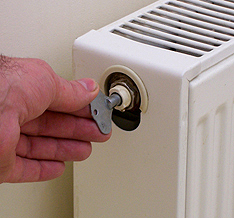 |
 |
Home
Tools
Drilling and Fixing
Putting Things Up
Repairs/Maintenance
Plumbing
Electrics
Woodwork
Decorating a Room
Tiling
Safety & Security
Saving Energy
House and Finance
Health&Safety
Disclaimer
Contact
Advertising
Useful Links
Site Map
| How to bleed a radiator | |||||||||
Bleeding a radiator is a fairly straight forward DIY job but there are a few things to consider before you begin. |
|||||||||
Are your radiators warm at the bottom but cold at the top? This is usually due to air in the system. It most commonly happens after you've had the heating off for lengthy periods. If you've got some air in your heating system it will work it's way around and eventually get lodged in the very top section of some radiators. They will feel warm at the bottom but quit cool at the top. If you live in a home with several floors it's usually the top floors that suffer the most as the air eventually works it's way to the top. You might notice the top floors rooms feel cooler than below as they don't come up to full temperature due to the trapped air. |
|||||||||
 |
|||||||||
How to bleed a radiator The bleed point is at the top on one side of the radiator. With the heating off and radiators cold, put the key in and gently turn a quarter turn anticlockwise. Unscrew the bleed screw just enough so you hear air hiss out. The hissing sound shows that there is air trapped inside. When all the air has been released some water should then start to come out. Get ready to quickly tighten it up as soon as water starts to come out. I like to have some kitchen towel handy to catch any water as it tends to be a dirty brown colour and might mark the carpet. IMPORTANT: If your heating is a gravity sysytem (a cold water feed tank in the loft(or up high) and a hot water cylinder) then you don't need to worry about repressurising because gravity sytems work on low pressure, and the system will top itself up. |
|||||||||